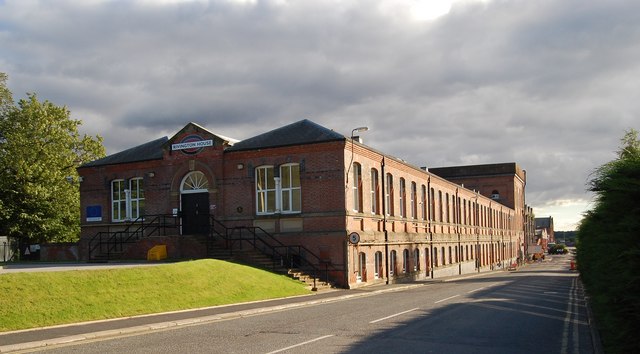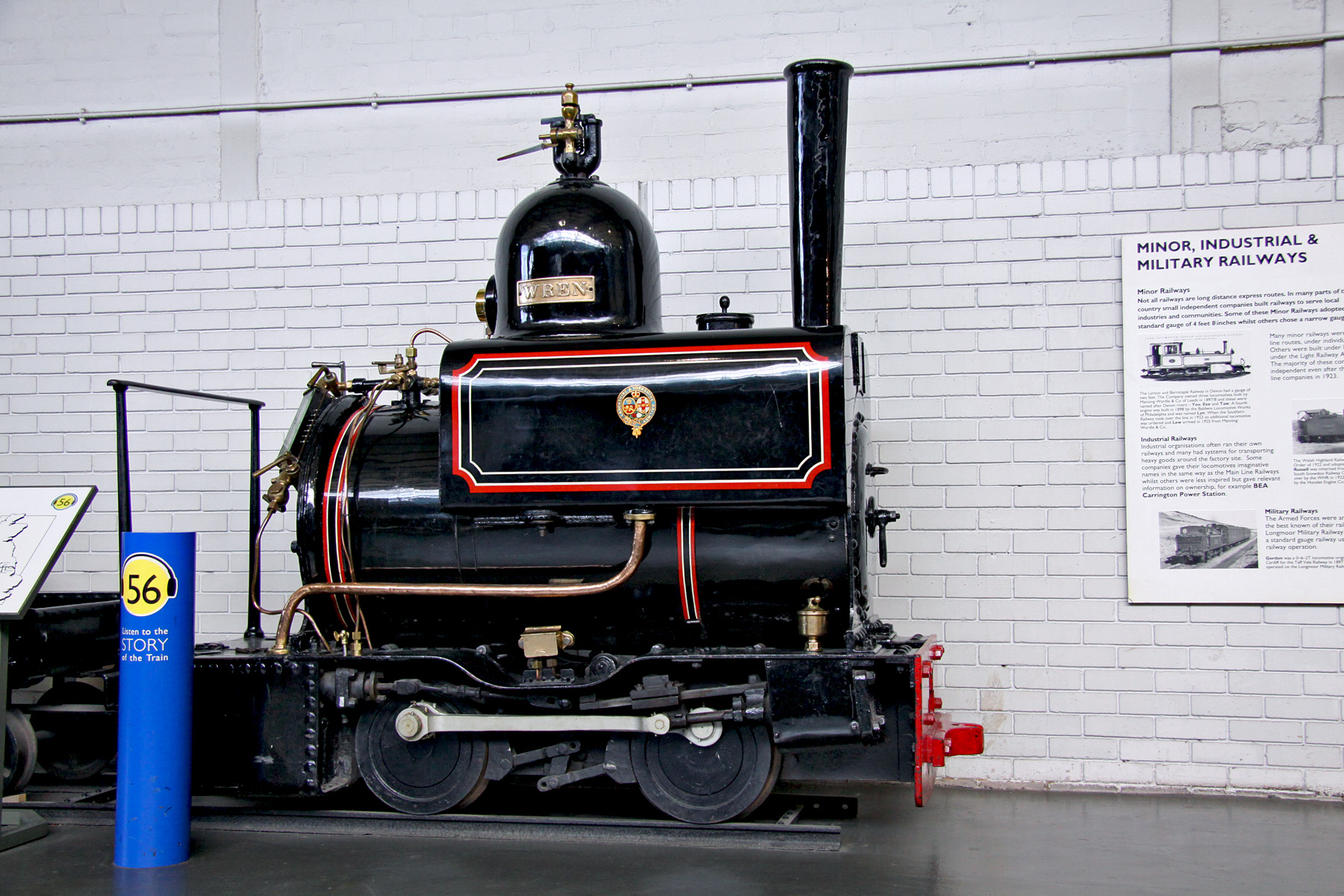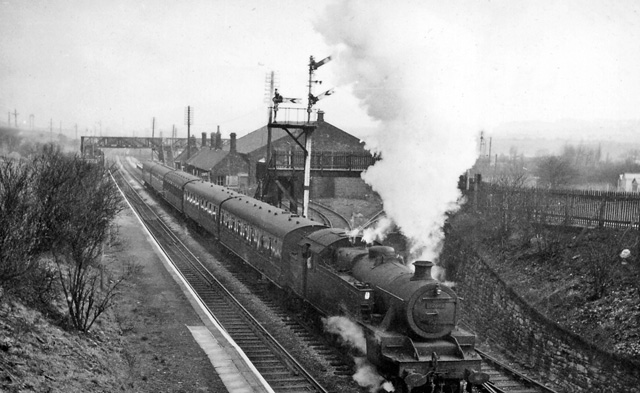|
Horwich Railway Station
Horwich railway station was located in Lancashire, England on a branch from the Manchester to Preston Line. It was closed to passengers on 27 September 1965 and to goods on 25 April 1966. Opened on 14 February 1870 to serve the town of Horwich (now in Greater Manchester) but by 1884 the land to the east of the branch line, south of the town had been chosen for a major locomotive works. Horwich railway station closed to passenger traffic on 27 September 1965, and goods the next year. Thirty-four years later Horwich Parkway railway station opened in 1999, adjacent to the Reebok Stadium. The nearest railway station to Horwich is now Blackrod. The line to Horwich Works remained open until their closure in 1983. The station has been demolished and the site is a public park. See also *Horwich Parkway railway station Horwich Parkway is a railway station serving the town of Horwich and Middlebrook near Bolton, in Greater Manchester, England. Located within the historic co ... [...More Info...] [...Related Items...] OR: [Wikipedia] [Google] [Baidu] |
Horwich
Horwich ( ) is a town and civil parish in the Metropolitan Borough of Bolton, Greater Manchester, England. Prior to 1974 in the historic county of Lancashire. It is southeast of Chorley, northwest of Bolton and northwest of Manchester. It lies at the southern edge of the West Pennine Moors with the M61 motorway passing close to the south and west. At the 2011 Census, Horwich had a population of 20,067. Horwich emerged in the Middle Ages as a hunting chase. Streams flowing from the moors were harnessed to provide power for bleachworks and other industry at the start of the Industrial Revolution. The textile industry became a major employer and after 1884 the construction of the railway works caused the population of the town to increase dramatically. The old industries have closed and urban regeneration has been led by out of town developments, particularly at Middlebrook, which, since 1997 has been the base of Bolton Wanderers football club, who play at the University of ... [...More Info...] [...Related Items...] OR: [Wikipedia] [Google] [Baidu] |
Horwich Works
Horwich Works was a railway works built in 1886 by the Lancashire and Yorkshire Railway (LYR) in Horwich, near Bolton, in North West England when the company moved from its original works at Miles Platting, Manchester. Buildings Horwich Works was built on of land bought in April 1884 for £36,000. Rivington House, the first of several workshops was long by wide and opened in February 1887. The long brick built workshops had full-height arched windows and were separated by tram and rail tracks. Work to construct the three bay, long by wide, erecting shop began in March 1885. Inside were 20 overhead cranes. An gauge railway, with approximately of track was built to carry materials around the works complex, modelled on a similar system at Crewe Works. Two small 0-4-0 tank locomotives were bought from Beyer, Peacock and Company in 1887 to haul stores trains around the site, and six more were acquired at intervals to 1901. The first of these was bought from Beyer Peacock, bu ... [...More Info...] [...Related Items...] OR: [Wikipedia] [Google] [Baidu] |
Demolished Buildings And Structures In Greater Manchester
Demolition (also known as razing, cartage, and wrecking) is the science and engineering in safely and efficiently tearing down of buildings and other artificial structures. Demolition contrasts with deconstruction, which involves taking a building apart while carefully preserving valuable elements for reuse purposes. For small buildings, such as houses, that are only two or three stories high, demolition is a rather simple process. The building is pulled down either manually or mechanically using large hydraulic equipment: elevated work platforms, cranes, excavators or bulldozers. Larger buildings may require the use of a wrecking ball, a heavy weight on a cable that is swung by a crane into the side of the buildings. Wrecking balls are especially effective against masonry, but are less easily controlled and often less efficient than other methods. Newer methods may use rotational hydraulic shears and silenced rock-breakers attached to excavators to cut or break thro ... [...More Info...] [...Related Items...] OR: [Wikipedia] [Google] [Baidu] |
Beeching Closures In England
Beeching is an English surname. Either a derivative of the old English ''bece'', ''bæce'' "stream", hence "dweller by the stream" or of the old English ''bece'' "beech-tree" hence "dweller by the beech tree".''Oxford Dictionary of English Surnames'', Reaney & Wilson, Oxford University Press 2005 People called Beeching include:- * Henry Charles Beeching (1859–1919) clergyman, author and poet * Jack Beeching (John Charles Stuart Beeching) (1922–2001), British poet * Richard Beeching (1913–1985), chairman of British Railways * Thomas Beeching (1900–1971), English soldier and cricketer * Vicky Beeching (Victoria Louise Beeching) (born 1979), British-born Christian singer See also * Beeching Axe The Beeching cuts (also Beeching Axe) was a plan to increase the efficiency of the nationalised railway system in Great Britain. The plan was outlined in two reports: ''The Reshaping of British Railways'' (1963) and ''The Development of the ..., informal name for th ... [...More Info...] [...Related Items...] OR: [Wikipedia] [Google] [Baidu] |
Railway Stations In Great Britain Closed In 1966
Rail transport (also known as train transport) is a means of transport that transfers passengers and goods on wheeled vehicles running on rails, which are incorporated in tracks. In contrast to road transport, where the vehicles run on a prepared flat surface, rail vehicles (rolling stock) are directionally guided by the tracks on which they run. Tracks usually consist of steel rails, installed on sleepers (ties) set in ballast, on which the rolling stock, usually fitted with metal wheels, moves. Other variations are also possible, such as "slab track", in which the rails are fastened to a concrete foundation resting on a prepared subsurface. Rolling stock in a rail transport system generally encounters lower frictional resistance than rubber-tyred road vehicles, so passenger and freight cars (carriages and wagons) can be coupled into longer trains. The operation is carried out by a railway company, providing transport between train stations or freight customer facilit ... [...More Info...] [...Related Items...] OR: [Wikipedia] [Google] [Baidu] |
Railway Stations In Great Britain Opened In 1870
Rail transport (also known as train transport) is a means of transport that transfers passengers and goods on wheeled vehicles running on rails, which are incorporated in tracks. In contrast to road transport, where the vehicles run on a prepared flat surface, rail vehicles (rolling stock) are directionally guided by the tracks on which they run. Tracks usually consist of steel rails, installed on sleepers (ties) set in ballast, on which the rolling stock, usually fitted with metal wheels, moves. Other variations are also possible, such as "slab track", in which the rails are fastened to a concrete foundation resting on a prepared subsurface. Rolling stock in a rail transport system generally encounters lower frictional resistance than rubber-tyred road vehicles, so passenger and freight cars (carriages and wagons) can be coupled into longer trains. The operation is carried out by a railway company, providing transport between train stations or freight customer facilit ... [...More Info...] [...Related Items...] OR: [Wikipedia] [Google] [Baidu] |
Former Lancashire And Yorkshire Railway Stations
A former is an object, such as a template, gauge or cutting die, which is used to form something such as a boat's hull. Typically, a former gives shape to a structure that may have complex curvature. A former may become an integral part of the finished structure, as in an aircraft fuselage, or it may be removable, being using in the construction process and then discarded or re-used. Aircraft formers Formers are used in the construction of aircraft fuselage, of which a typical fuselage has a series from the nose to the empennage, typically perpendicular to the longitudinal axis of the aircraft. The primary purpose of formers is to establish the shape of the fuselage and reduce the column length of stringers to prevent instability. Formers are typically attached to longerons, which support the skin of the aircraft. The "former-and-longeron" technique (also called stations and stringers) was adopted from boat construction, and was typical of light aircraft built until the ... [...More Info...] [...Related Items...] OR: [Wikipedia] [Google] [Baidu] |
Horwich Branch
The Horwich Branch was a double track branch Lancashire and Yorkshire Railway built branch line that ran from two forks either side of Blackrod railway station on the Manchester to Preston Line to also serving the Horwich Works. History Opening The line opened on 14 February 1870 to serve the town of Horwich, but by 1884 the land to the east of the line south of the town had been chosen for a major locomotive works. Horwich station closure Horwich Railway Station closed to passenger traffic on 27 September 1965, and goods the next year. The line to Horwich Works remained open until their closure in 1983. Horwich Parkway station opening Thirty-four years later Horwich Parkway railway station opened in 1999, adjacent to Reebok Stadium. The nearest railway station to much of Horwich (including the town centre), however, is Blackrod Blackrod is a town and civil parish in the Metropolitan Borough of Bolton, Greater Manchester, England, northeast of Wigan and west of Bolton. ... [...More Info...] [...Related Items...] OR: [Wikipedia] [Google] [Baidu] |
Blackrod Railway Station
Blackrod railway station serves the village of Blackrod and the town of Horwich, England, 6.5 miles (10 km ) north west of railway station. It is just from the town centre of Horwich - closer than station. It lies on the Manchester-Preston Line and is served by Northern Trains, who run express trains from to . Despite its high passenger usage and the recent refurbishment (see below) the station is currently unstaffed. A drop in passenger usage in the year 2017/18 is largely due to industrial action and engineering works with the drop in the year 2020/21 due to the COVID-19 pandemic and reduced timetable. History The station was opened on 4 February 1841 as Horwich Road by the Manchester and Bolton Railway. It was renamed Horwich and Blackrod, then Horwich Junction, then Horwich and Blackrod junction, and finally Blackrod in 1888 Blackrod was once the junction for a short branch to serve the original Horwich station (closed to passengers on 27 September 1965) ... [...More Info...] [...Related Items...] OR: [Wikipedia] [Google] [Baidu] |
Metropolitan Borough Of Bolton
'')'' , image_skyline =Bolton Town Hall.jpg , imagesize = 250px , image_caption = Bolton Town Hall, the seat of Bolton Council , image_blank_emblem = Coat of arms of Bolton Metropolitan Borough Council.png , blank_emblem_type = Coat of Arms of the Metropolitan Borough Council , blank_emblem_size = 150px , blank_emblem_link = , image_map = Bolton UK locator map.svg , map_caption = Bolton shown within Greater Manchester , subdivision_type = Sovereign state , subdivision_name = United Kingdom , subdivision_type1 = Constituent country , subdivision_name1 = England , subdivision_type2 = Region , subdivision_name2 = North West England , subdivision_type3 = Ceremonial county , subdivision_name3 = Greater Manchester , subdivision_type5 = Historic county , subdivision_name5 = Salford Hundred, Lancashire , subdivision_type4 = Admin HQ , subdivision_name4 = Bolton Town Hall , government_footnotes = , government_type = Metropolitan borough , leader_title = Governing body , leader_na ... [...More Info...] [...Related Items...] OR: [Wikipedia] [Google] [Baidu] |
Reebok Stadium
The University of Bolton Stadium is the home ground of Bolton Wanderers F.C. in Horwich, Greater Manchester, England. Opening in 1997, it was named the Reebok Stadium, after club sponsors Reebok. In 2014, Bolton Wanderers signed a naming rights deal with Italian sportswear company Macron. It was renamed the University of Bolton Stadium in 2018. In UEFA matches, it is called Bolton Wanderers Stadium due to UEFA regulations on sponsorship. A hotel forms part of the stadium and some of the rooms offer views of the pitch. History University of Bolton Stadium is an all-seater stadium with a capacity of almost 29,000 and was completed in 1997, replacing the club's old ground, Burnden Park. Burnden Park, which at its peak had held up to 60,000 spectators, was becoming increasingly dilapidated by the 1980s, and a section of terracing was sold off for redevelopment as a supermarket to help pay off the club's rising debts. Bolton Wanderers had dropped into the Third Division in 198 ... [...More Info...] [...Related Items...] OR: [Wikipedia] [Google] [Baidu] |






